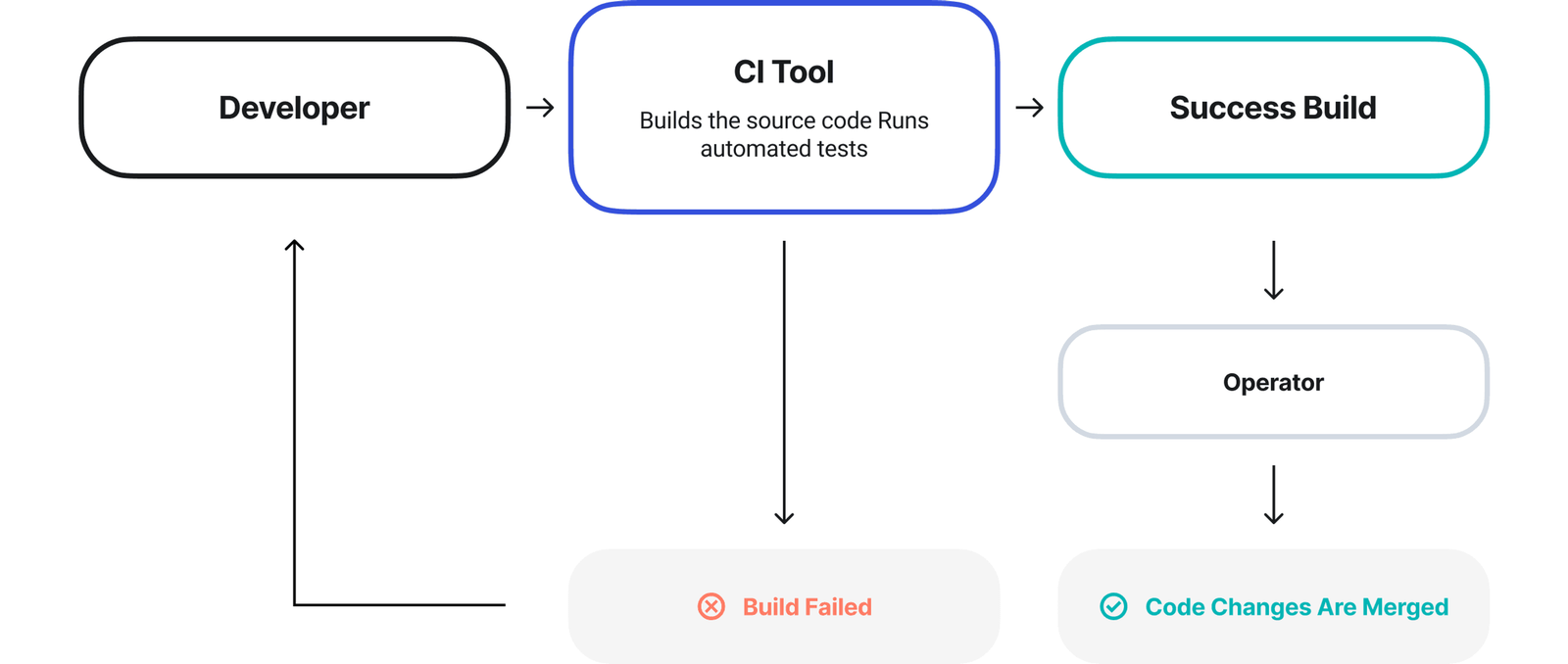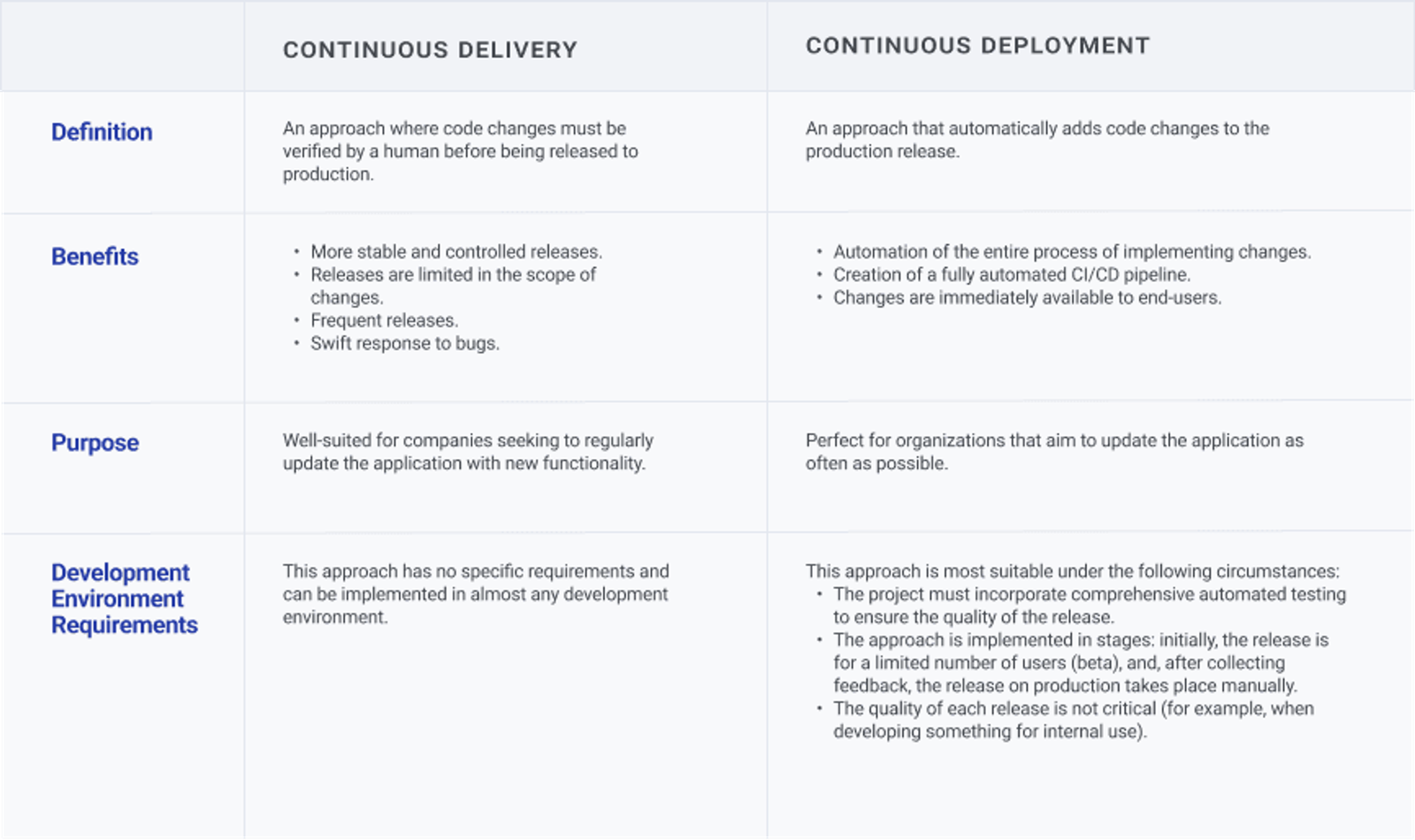Author: Arthur Radchenko | Front End Engineer at Coherent Solutions Ukraine
Not too long ago, developers used to work independently for extended periods of time and then merge their work into a single branch after completing their specific tasks. This way of communicating among team members often resulted in a build-up of numerous bugs and defects over time, with no timely resolution. As a result, integrating code changes became a challenging and time-consuming process, hindering the prompt delivery of updates to users.
In response to these challenges, new approaches for change delivery, collaboration, and team responsibilities began to emerge.
Definition
Continuous integration, delivery, and deployment are processes designed to streamline the implementation of changes in an application, enabling their swift deployment to various environments (production, staging, development, etc.). This is typically achieved by establishing pipelines that automate specific repetitive actions.
The diagram visually represents the processes associated with each approach. Although these approaches are depicted together, in practice, organizations often opt for either continuous delivery or deployment, depending on what aligns best with their internal development processes. So, let’s delve into these approaches and explore each of them in more detail.

Continuous Integration
Continuous integration is the process of frequently merging code changes from multiple contributors into a single repository. But why is it so crucial? In today’s landscape, most repositories are set up to trigger a series of processes whenever a developer makes changes to the version control system. These processes include checking the core functionality of the code, running tests, ensuring adherence to formatting rules, and compiling the latest version of the code to catch any errors that could potentially lead to build failures. All these steps are vital for spotting potential bugs early on, improving the overall quality of the final product, and reducing the time needed for verification and the release of new features. While bugs can’t be entirely avoided, continuous integration plays a key role in promptly identifying and addressing them. This is the primary reason why businesses are transitioning away from traditional approaches to CI.
After continuous integration, the changes advance to the continuous delivery stage and deployment for end-user access. Code changes undergo various improvements and feedback loops before being released to the production environment. In a continuous delivery process, the team has the flexibility to decide how and when to introduce new updates to customers.
To further streamline the deployment process, continuous deployment comes into play as a fully automated approach. Although continuous deployment and continuous delivery have specific definitions, they both share the common objective of automating and optimizing the development process. In certain situations, continuous delivery and deployment are combined to maximize the benefits of both approaches.
Consider this example: In most of the projects I’ve been a part of, automatic pipelines are set up to run with every commit. Here’s how it typically works: I create a branch on GitHub, make code changes, and, once done, push the code to a public repository. Jenkins takes over by executing a pipeline that includes formatting checks, tests, and project builds. If there’s an error at any stage, the pipeline result is displayed on the pull request page, preventing the merging of the branch. As a result, the error needs fixing, and a new successful pipeline becomes a prerequisite for closing the pull request and merging my branch into the codebase. This ensures that we have well-tested and proven functionality ready to advance to the next phase.

Continuous Delivery and Deployment
After considering the initial phase of automation processes, let’s move to the stage when we have thoroughly tested functionality that should be included in the upcoming release. This is where continuous delivery and deployment come into play. What do these terms mean? Essentially, they involve the automated introduction of the latest version of the product into production and other environments. However, before this happens, the code must undergo automated unit, integration, and system testing, conducted during the integration stage.
Now, let’s explore another process known as continuous deployment. This represents the next step in deploying changes to the environment. Essentially, continuous deployment is a development practice where any code changes are automatically pushed into the production environment as soon as they are ready. The primary goal of this process is to release developers’ changes and deliver them to end users as frequently and rapidly as possible. So, when a new release is prepared, the pipeline takes over, verifies that all checks are completed, and generates a build that will be promptly deployed to production. It’s crucial to note that no human intervention is involved in this process, and the code will only be deployed to the environment if all the checks pass; otherwise, the deployment will not proceed.

What is the Difference between Continuous Delivery and Deployment?
Frequently, people mistakenly use these two terms interchangeably, but they actually have significant differences that you may have already observed. In simple terms, continuous delivery focuses on ensuring that the code is prepared for release and deployment to production, but this only occurs with the oversight of the person managing the process. On the other hand, continuous deployment simplifies this process by automatically pushing code changes to the environment as soon as the test plans are successfully completed.
Which approach is better? It entirely depends on the specific product’s needs. If the goal is to swiftly deliver changes to end-users and shorten the feedback loop, deployment is the preferable choice; if the code implementation process for end-users needs to be manually controlled and verified before release, delivery is the more suitable option. However, certain products may demand one approach over the other. For instance, web platforms or applications may benefit from going through quality assurance before reaching end users, making continuous delivery the preferred approach. Conversely, for monolithic applications or specific databases, continuous deployment could be the optimal choice.
Despite their differences, continuous deployment and continuous delivery share common elements. Both rely on the project’s infrastructure and monitoring systems to ensure consistent product support and to identify most bugs before implementing specific changes.
Now, let’s break down the distinctions between deployment and delivery in a comparison table.

Now that we’ve defined these two processes, let’s look at an example. Remember when we talked about getting a successful build in the continuous integration section? After that, the QA team comes in to make sure the new features work correctly based on the business logic of the application.
Our team lead regularly updates the staging environment with the latest version of the new feature build. And the cool part? All of this happens seamlessly using Jenkins, the automation server. Jenkins lets us specify what needs to be deployed and where. Once a release’s functionality is thoroughly tested, any identified problems are fixed, and all related tickets are closed, we can make that functionality available to end-users.
Unfortunately, I haven’t personally worked in a setup where continuous deployment is used, but based on the descriptions, it seems the main difference lies in who handles deploying updates to the environment.
Conclusion
Let’s break down the three main steps for implementing changes and features during development. Essentially, continuous integration involves automated testing and verification of code changes. This lets you test specific parts or the entire application with each code update. On the other hand, continuous delivery and deployment involve putting tested functionality, bug fixes, and so forth into a working environment.
We’ve also pointed out a crucial difference between continuous delivery and deployment: continuous delivery ensures that functionality is always ready for release and waits for a manual command to deploy, while continuous deployment automatically rolls out changes right after passing tests. Both approaches aim to streamline the process of making changes and releasing updates. Each approach has its own strengths and is tailored to specific DevOps service needs. Ultimately, it’s your call to decide which one to adopt.
Read also: Exploring CI/CD Tools: Maximizing Organizational Impact



